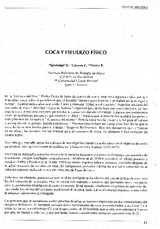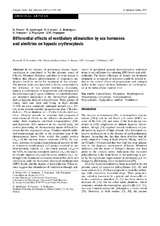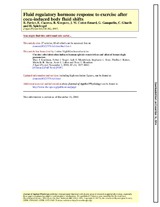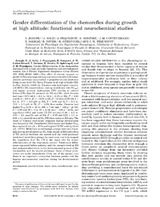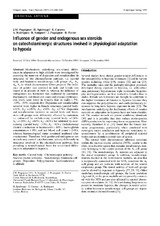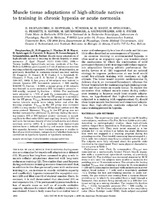Listar Facultad de Medicina, Enfermería, Nutrición y Tecnología Médica por autor "Favier, R"
Mostrando ítems 1-7 de 7
-
Coca y esfuerzo físico
Spielvogel, H; Cáceres, E; Favier, R (Instituto Boliviano de Biología de Altura, 1997)En la “Crónica del Perú” Pedro Cieza de León da cuenta de que al inquirir a algunos indios por qué mascaban coca, ellos respondieron que al hacerlo “sienten poca hambre y se hallan en gran vigor y fuerza”. Cuatrocientos ... -
Differential effects of ventilatory stimulation by sex hormones and almitrine on hypoxic erythrocytosis
Favier, R; Spielvogel, Hilde; Cáceres, E; Rodríguez, A; Sempore, B; Pequignot, J; Pequignot, JM (Pflugers Arch-Eur J Physiol, 1997)Abstract. In the absence of pulmonary disease, hypoventilation is considered to be the primary cause of Chronic Mountain Sickness, and there is some reason to believe that chronic administration of respiratory analeptics ... -
Fluid regulatory hormone response to exercise after coca-induced body fluid shifts
Favier, R; Cáceres, E; Sempore, B; Cottet-Emard, JM; Gauquelin, G; Gharib, C; Spielvogel, H (American Physiological Society, 1997)To determine the effect of coca chewing on heart rate (HR), mean arterial blood pressure (MAP), and plasma volume and their relationship with the hormones regulating cardiovascular and body fluid homeostasis, 16 male ... -
Gender differentiation of the chemoreflex during growth at high altitude : functional and nerurochemical studies
Joseph, V; Soliz, J; Pequignot, J; Sempore, B; Cottet-Emard, JM; Dalmaz, Y; Favier, R; Spielvogel, Hilde; Pequignot, JM (Am J Physiol Regulatory Integrative Comp Physiol, 2000)The effect of chronic hypoxia on gender differences in physiology and neurochemistry of chemosensory pathways was studied in prepubertal and adult rats living at sea level (SL; Lyon, France) or at high altitude (HA; La ... -
Hormonal and metabolic adjustments during exercise in hypoxia or normoxia in highland natives
Favier, R; Desplanches, D; Hoppeler, H; Cáceres, E; Grunenfelder, A; Koubi, H; Leuenberger, M; Sempore, B; Tüscher, L; Spielvogel, H (J Appl Physiol, 1996)Abstract In sea-level natives, exposure to hypoxia for a few weeks is characterized by an increased dependence on blood glucose and a decreased reliance on lactate for energy metabolism during exercise. These metabolic ... -
Influence of gender and endogenous sex steroids on catecholaminergic structures involved in physiological adaptation to hypoxia
Pequignot, JM; Spielvogel, H; Cáceres, E; Rodríguez, A; Sempore, B; Pequignot, J; Favier, R (Pflugers Arch-Eur J Physiol, 1997)Abstract. Mechanisms underlying sex-related differences in adaptation to high altitude were investigated by assessing the turnover of dopamine and noradrenaline in structures of the chemoafferent pathway, i.e. carotid body ... -
Muscle tissue adaptations of high-altitude natives to training in chronic hypoxia or acute normoxia
Desplanches, D; Hoppeler, H; Tüscher, L; Mayet, MH; Spielvogel, H; Ferretti, G; Kayser, B; Leuenberger, M; Grünenfelder, A; Favier, R (American Physiological Society, 1996)Abstract. Twenty healthy high-altitude natives, residents of La Paz, Bolivia (3,600 m), participated in 6 wk of endurance exercise training on bicycle ergometers, 5 times/wk, 30 min/session, as previously described in ...

